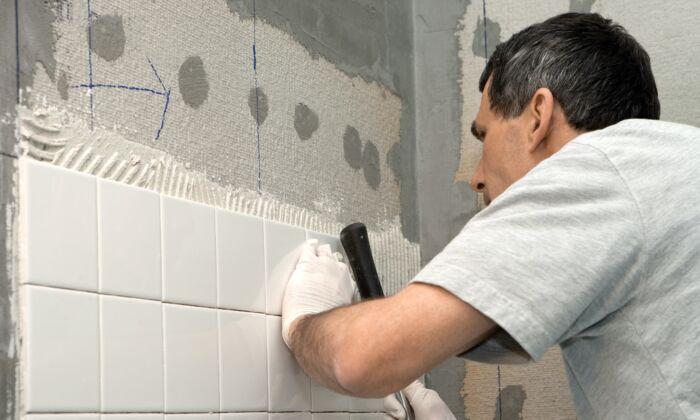Using the proper materials and procedures can ensure your new shower tile job will last a lifetime. You should think of your shower tile job as a multistep project of its own with attention to detail at each step. Take your time and do it right or you will just have to do it again in seven or eight years.
First, here is the basic design theory of a tiled shower wall. The entire wall system consists of the lumber structure inside the wall. Over this, a waterproof vapor barrier is installed. Over the vapor barrier, tile backer board is attached. The ceramic tile is set on the backer board and the spaces between the tiles are filled with grout.
With this in mind, let’s get started. You have two basic backer board options: special moisture-resistant drywall and cement board. Even though the special drywall has water-repellent emulsions in the gypsum core and on the paper covering, it is not waterproof. Any leaks through the grout can damage it over time, as you saw on your existing shower wall.
Cement board is clearly the best choice for shower applications. Builders do not often use it because it is much heavier to handle and more difficult to cut. If you are concerned about handling the weight, USG makes a cement backer board impregnated with tiny foam balls to lower the weight. James Hardie and W.R. Bonsal also make cement backer boards.
Although 1/4-inch cement board is available (it’s often used for countertops), you should probably use 1/2-inch cement board for your shower wall. To cut it, you can score it and snap it, but this leaves a rough edge. It is easiest to use a circular saw with a masonry blade. It gets dusty, so wear a mask, use an old saw that you don’t mind damaging, and do it outdoors. Score the holes for the plumbing and gently chip it out with a chisel.
Even though you think that you cleaned off all the dust outdoors, some will still fall on the bathroom floor when you handle it. This dust and the chips are very abrasive. If your bathroom floor is already finished, be sure to cover it with a plastic film and then a drop cloth. Without the plastic, the abrasive dust will quickly work its way through the drop cloth.
Place the vapor barrier (cross-laminated polyethylene is best) over the wall studs. Position the backer board so that there is a slight gap, about 1/4 inch, above the bathtub. This will eliminate capillary action where the water is drawn up behind it.
Attach the cement backer board with screws or nails. Use them on eight-inch centers to secure the board. Although many builders cut corners and only run the cement board up about three feet, it is recommended that you run it up almost as high as the tile will go.
Most cement board manufacturers recommend that you tape the joints similar to drywall. Special waterproof fiberglass tape and thinset make the longest-lasting job.






